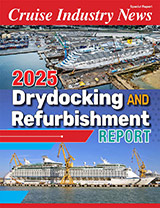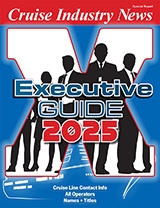The one-day cruise industry has port authorities and city planners from Atlantic City to San Diego scrambling to attract day cruise operations to their areas. According to a 1989 market study performed by Post, Buckley, Schuh & Jernigan, a Miami-based consulting firm, within the past four years the total day-cruise passenger volume has grown at annual rate of 16.2 percent. The study showed that in 1988 2,166,398 people took a day cruise, compared to 736,014 in 1985. This is largely attributed to the appearance of five new day-cruise operations all within the past 17 months.
Dr. Stanley Buchin, Senior Vice President of Temple, Barker & Sloane, a Massachusetts based management consulting firm, noted that the ships operating in the one-day market were mainly older vessels and that the market would have even stronger growth potential if new vessels were to be introduced.
Attractive
Studies show that day cruises appeal to a highly diverse market: from the middle income vacationer who has never cruised, to the more affluent, more experienced cruiser. Day cruises to nowhere will start for as little as $39 per person, and destination cruises start at approximately $89 per person. Industry insiders report that more people are apt to take an extended cruise after experiencing a one day cruise.
Along with dining and nightclub entetainment, day-cruises also offer casino gambling in areas where gambling may not otherwise be permitted. James Forbes, Gaming Operations Manager for Casinos Austria in Miami, said that day cruises are a one-day entertainment experience. According to Forbes, many day cruise ships have more intenor free space available and therefore more casino space than regular overnight vessels and gambling often becomes a more important part of the trip.
New Lines
Discovery Cruises, Tropicana Cruises, and recently, Europa Cruise Line have positioned themselves in the highly competitive Florida market, while Islander Cruise and Pride Cruise Lines have found their niches in Port Isabel Texas, and Gulfport, Mississippi. Yet despite the fact that each of these lines has operated remarkably well in their markets, legislative problems have haunted two of the lines and may threaten the future operations of one of them.
Legislative Problems
Before they could begin sailing, both Europa which originally operated out of Biloxi, Mississippi, and Pride had to fight State legislation prohibiting the selling of bonded whiskey, and the operation of casino gambling concessions within American waters. Delaying these activities until the ships were in the Gulf of Mexico proved too costly to each lines’ operations, and prompted an appeal to the State. Although Europa was allowed to begin casino operations while in the Mississippi Sound, that order was rescinded upon learning that permission was granted base upon faulty navigational charts. Europa, which was already operating the EuropaSun out of St. Petersburg, Florida, decided to put the EuropaStar there as well. Biloxi is currently seeking a new day-cruise operator.
Last March, Pride received permission to operate the 586-passenger Pride of Mississippi’s gambling concessions just 1,500 yards offshore on their day trips to nowhere and monthly cruises to Mexico. However, there was a clause requiring the ship to change from Bahamian registry to American flag within the next two years.
Under the Jones Act, a ship operating under American flag must cease all gaming concessions while in U.S. waters. Although the ship may have to be repositioned or cease operations, Pride’s president Bill Dougall said that he’s “not going to worry about that as if it were tomorrow.” Pride also signed a letter of intent with Galveston to begin day operations there this fall, but again, problems with legislation may delay the lines activities in the area.
But not all of the lines have had as tremulous a start as these two. Tropicana Cruises, a subsidiary of Sea Venture Cruises, began operations December 23, and according to a spokesperson for the line, the ship is sailing at better than 75 percent capacity, claiming that the 1,200-passenger Tropicana is more luxurious than most day-cruise ships offering amenities such as a large swimming pool and a la carte dining. With their full day cruise sailing to Bimini, Bahamas, for $119 per person, Tropicana’s day-cruise may also be the most expensive in the industry.
Seventeen-year industry veteran Martin Salzito, President of Discovery Cruises in Miami, said that although they began operations 16 months ago, the past three months have been ‘really lucrative’. Not willing to expand on that, Salzito noted that the 1,250-passenger Discovery 1 has been operating at 85 percent capacity with a good percentage of repeat passengers. Salzito also said that although he couldn’t detail their future plans, the line is looking for new homeports in Florida and California.
Islander Cruises’ 500-passenger Le Mistral has the smallest capacity level of the new ships introduced. Day cruises to Mexico have operated at approximately 50 percent capacity, and the line has plans to increase the length of the cruises from eight to ten hours.
New Ports
Joan Sanchez, cruise industry consultant for PBS&J said that providing there is a positive flow of visitors to the area, and the product is of high quality, the future earnings potential for day cruises can “soar off the charts.” Although none of the cruise lines were willing to speculate about potential new ports, currently, Atlantic City and Newport News, Virginia are awaiting PBS&J studies on the feasibility of day cruise operations in those areas. Cities homeporting day-cruisers could expect to make an estimated $1.25 to $10 million annually, depending on the city. Paul Miller, City Director,of Planning and Economic Development for Newport News said he is “very hopeful” that their $80,000 study will show that a day and/or night cruise business will prove lucrative to the area. Newport News is supported in tourism by Williamsburg/Busch Gardens, Norfolk, and Virginia Beach: in 1987 tourists spent a record $6.9 billion dollars in that area.
Suzanne Longacre, Atlantic County Tourism Development Planner, said that while awaiting their $8,000 market study, the board has located two or three potential sites on the inlet which could serve as a cruise facility. According to Longacre, due to the surplus of attractions to the area, including casino gambling and the boardwalk, Atlantic City is an ideal one-day cruise area. There is established air and land transportation to the city and markets of 100 million people are within a three to four hour drive.
On the West Coast, Don Harrison, Executive Director for the San Diego Cruise Consortium, has been waiting for a new day-cruise operation since Crown Cruise Line repositioned the 700-passenger Viking Princess to Palm Beach in 1986. When Crown left, San Diego lost an estimated $5 million annually and although there has not been a day operation since, Harrison said that recently the port has been inundated with proposals, from cruise lines such as Discovery and SeaEscape, and consortiums-mostly consortiums. Harrison said that a final decision will be based upon submitted analysis of financial capabilities, complete assessment of gaming operations potential, and prior day cruising and gaming experience. San Diego expects a new day-cruise business to bring in approximately $8 – $10 million to the port and the community in port charges and services, hotel packages, and jobs.
Established
Miami-based SeaEscape, touted as the innovator of the consistent one-day product, began eight years ago out of Port Canaveral, and is currently the only day operator with a fleet of four ships. Operating out of Miami, Canaveral, Everglades and St. Petersburg, SeaEscape is competing with Tropicana, Discovery, Europa and Crown. Jerry Butcher, Vice President, Sales and Marketing for the line is not concerned. “Competition enhances a product and helps keep the business on its toes.” Butcher said.
Butcher added that SeaEscape is so certain of their product-offering they are forecasting 900,000 passengers for 1989, “which is more than some overnight cruise lines make”. The 926-passenger Scandanavian Sky and Scandanavian Star, the 1,150-passenger Scandanavian Sun, and the 1,050-passenger Scandanavian Saga have been operating at approximately 70 percent capacity. Butcher noted that their success is due largely to co-marketing efforts with both local and Bahamian hotels, ports, and tourist boards.
Breaking Away
Crown Cruise Line, which has operated exclusively out of the Port of Palm Beach since 1986, has built a solid local and regional marketbase.
In its first year of operations, 1985/86, Crown’s Viking Princess exceeded optimistic first year projections of 85,000 passengers, by carrying more than 100,000.
The Viking Princess, which recently underwent $1 million refurbishment, offers a variety of one-day cruises, sailing to Freeport, as well as Sunday morning brunch cruises, Wednesday coastline cruises and Friday night cruises.
According to Benson Murphy, Executive Port Director, the one-day operations of Crown generated more than $1 million in port revenues in 1988, making the cruise line the port’s second largest source of revenue. Crown estimated that about $8 million were generated for the local market through travel agents, suppliers, tour operators and hotels.
Crown, which is part of the Grundstad Shipping Group, is the only line to break out of the one day market and branch into the overnight and popular dive markets. Crown introduced the 486-passengers Crown Del Mar in January, which sails two- and five-night cruises to the Bahamas and the Western Caribbean, and plans on launching the 560-passenger Crown Monarch in the seven-day market next year. SeaEscape is also considering the possibility of branching into the overnight cruise market, but Butcher said there is nothing definite.
Future
The rapidly expanding day-cruise industry will see more competition within the next two years. Tropicana is planning to put the Calypso in a yet unnamed Florida port by the end of this year, while Discovery and SeaEscape are actively searching for new ports; if all goes well in Galveston, Texas will see two day operations open in their area.
Plans were also recently announced for a series of three catamaran-type ships to be deployed by different cruise lines in different markets, including Florida, Southern California and New York. But for lack of financing, the project has been abandoned.
With different studies showing that anywhere from 30 to 80 million Americans are potential passengers of cruises from three-days and more, the day-cruise market may be proportionately larger based on the lower rates.



